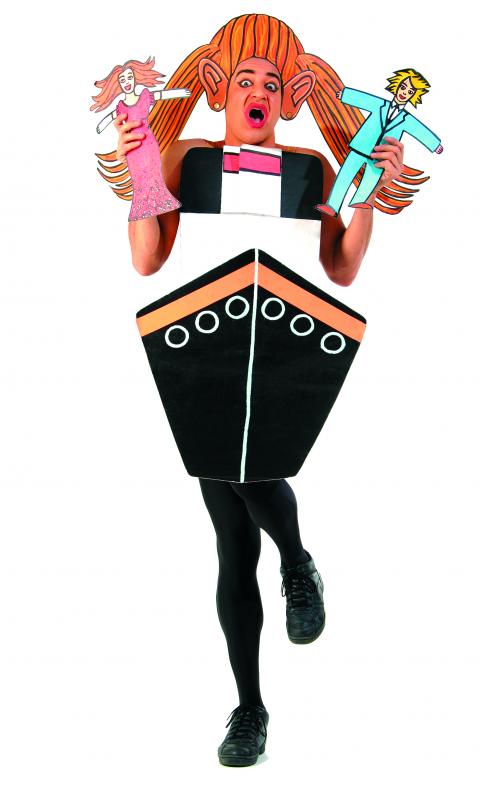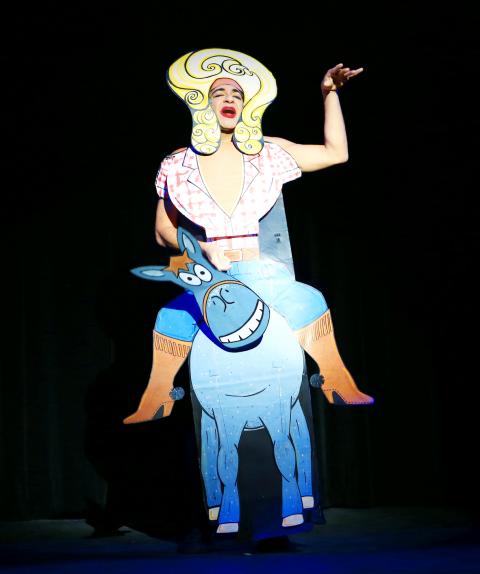A childhood love of Disney cartoons and growing up amid the marvelous fantasies of Venice’s annual carnival led to 57-year-old Italian comedian Ennio Marchetto’s unique career.
He went from entertaining family and friends with imitations of Marilyn Monroe in paper dresses to producing carnival costumes and masks.
Working in his father’s repair shop, Marchetto knew there had to be more for him than fixing expresso machines, and he began working on a comedy routine that combined mime, lip-synching and dance.

Photo courtesy of Ennio Marchetto
From local appearances around Venice, he developed a cabaret show featuring well-known Italian personalities and others, and then began to land spots on Italian television.
A few years later he began working with Dutch fashion and costume designer Sosthen Heenkam — who developed the origami technique that makes the rapid costume and hairpiece changes possible — and who helped Marchetto create enough characters that he could lip-sync through a full-length show.
The paper and cardboard costumes are cartoonish in their color palette and simplicity, but each centers on an iconic feature of the person or persons he is imitating.

Photo courtesy of Ennio Marchetto
His first appearance at the Edinburgh Festival helped put him on the international circuit, and for years he has made regular appearances in the UK and Germany, while traveling to scores of other countries.
His list of characters now numbers more than 300, ranging from movie stars and singers of all types to world leaders, famous paintings and painters.
Where else but in Marchetto’s The Living Paper Cartoon could one hope to see Mona Lisa, Disney’s Snow White, Beyonce, Queen Elizabeth, Edward Scissorhands or Elvis all in one show — or Doris Day morph into Dolly Parton astride a donkey or Liza Minelli turning into the Statue of Liberty as she belts out New York, New York? Then there is his cosmic shift from a white evening gown-clad Celine Dion into the Titanic.

Photo courtesy of Ennio Marchetto
Morph should be the technical term for his quick-change artistry, because with a fold of a piece of paper here, a pull-out there, a flip of a frock from front to back and turning around his headpiece, Marchetto shifts effortlessly from one character to another, rarely leaving the stage during his show.
He has finally brought The Living Paper Cartoon to Taiwan, where he will be appearing at the Cloud Gate Theater in New Taipei City’s Tamsui District (淡水) for three shows, starting tonight.

In the March 9 edition of the Taipei Times a piece by Ninon Godefroy ran with the headine “The quiet, gentle rhythm of Taiwan.” It started with the line “Taiwan is a small, humble place. There is no Eiffel Tower, no pyramids — no singular attraction that draws the world’s attention.” I laughed out loud at that. This was out of no disrespect for the author or the piece, which made some interesting analogies and good points about how both Din Tai Fung’s and Taiwan Semiconductor Manufacturing Co’s (TSMC, 台積電) meticulous attention to detail and quality are not quite up to

April 21 to April 27 Hsieh Er’s (謝娥) political fortunes were rising fast after she got out of jail and joined the Chinese Nationalist Party (KMT) in December 1945. Not only did she hold key positions in various committees, she was elected the only woman on the Taipei City Council and headed to Nanjing in 1946 as the sole Taiwanese female representative to the National Constituent Assembly. With the support of first lady Soong May-ling (宋美齡), she started the Taipei Women’s Association and Taiwan Provincial Women’s Association, where she

Chinese Nationalist Party (KMT) Chairman Eric Chu (朱立倫) hatched a bold plan to charge forward and seize the initiative when he held a protest in front of the Taipei City Prosecutors’ Office. Though risky, because illegal, its success would help tackle at least six problems facing both himself and the KMT. What he did not see coming was Taipei Mayor Chiang Wan-an (將萬安) tripping him up out of the gate. In spite of Chu being the most consequential and successful KMT chairman since the early 2010s — arguably saving the party from financial ruin and restoring its electoral viability —

It is one of the more remarkable facts of Taiwan history that it was never occupied or claimed by any of the numerous kingdoms of southern China — Han or otherwise — that lay just across the water from it. None of their brilliant ministers ever discovered that Taiwan was a “core interest” of the state whose annexation was “inevitable.” As Paul Kua notes in an excellent monograph laying out how the Portuguese gave Taiwan the name “Formosa,” the first Europeans to express an interest in occupying Taiwan were the Spanish. Tonio Andrade in his seminal work, How Taiwan Became Chinese,